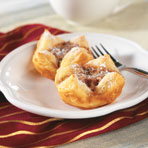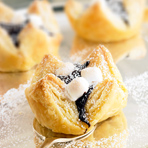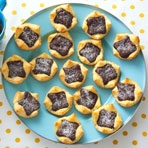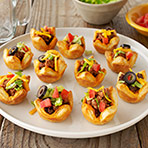All Recipes
-
Southern Pecan Crisps
These easy mini pecan tarts feature puff pastry squares filled with brown sugar, butter and pecans. You might want to double the recipe…they're really good!
-
Chocolate Peanut Butter Tartlets
Delicious and fast-fix sweets with a trio of favorite flavors–chocolate, marshmallow and peanut butter–are so easy to bake when you start with puff pastry sheets.
-
Fudgy Brownie Tartlets
Add these quick-fix mini desserts to your next buffet or serve with ice cream for dessert. They're so tasty, the kids will love them, but they're elegant too, so adults will enjoy!
-
Party Taco Tartlets
Add some spice to your next party with these bite-sized tacos in puff-pastry tartlets…finish with your favorite toppings, or let your guests top their own!
-
Baking Puff Pastry
Always preheat your oven for a minimum of 15-20 minutes before baking, because Puff Pastry depends on even heat to rise and puff. Place pastries 1 inch apart.
If you want a flaky thin and crispy pastry that’s not very puffy, prick the unbaked Puff Pastry all over with a fork, which lets steam escape while baking.
For a flatter pastry without much puff—like a Napoleon—prick the dough all over with a fork, place parchment paper on top, then place 1-2 cookie sheets on top of that to weigh it down.
If you’re making a tart or filled Puff Pastry, place it on the baking sheet before adding toppings or fillings. That way, you won’t have to transfer the dough with the extra weight and risk tearing it.
For extra-thin, crisp Puff Pastry, set a second baking sheet on top of the filled pastry before baking.
To create a tart with an extra puffy crust: take a knife and score two lines around the edge, then prick the area inside this border with a fork.
Puff Pastry fillings should be at room temperature. If they’re hot, they can begin to melt the pastry layers, which will affect the pastry’s ability to rise and puff.
The kind of pan you use can affect baking times. A nonstick or dark glazed baking sheet may bake faster, so adjust your time and check pastry while baking.
When baking Puff Pastry, note that it’s done when it’s golden and puffy, not wet and doughy. Use the baking time in the recipe as a guideline, and rely on your eyes as well.
You can bake Puff Pastry on a baking sheet lined with parchment paper. For a more even rise, place a sheet of parchment paper on top of your pastry as well.
How to tell if Puff Pastry is done baking? Take a sharp knife and nick off a teensy piece to test for crispness and flakiness.
Always use a preheated conventional oven to bake Puff Pastry, never a microwave or toaster oven, as they can’t achieve the right golden puffy effect.
If bubbles appear on the surface while baking Puff Pastry, prick with a fork to deflate them.
Always flip and place the cut side of the Puff Pastry down on the baking sheet.




